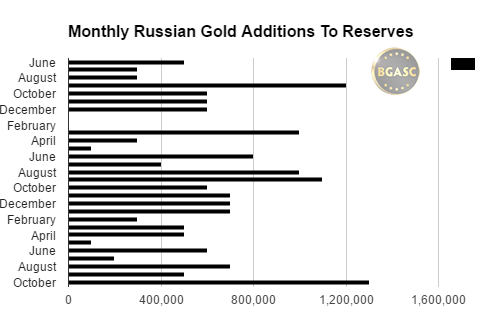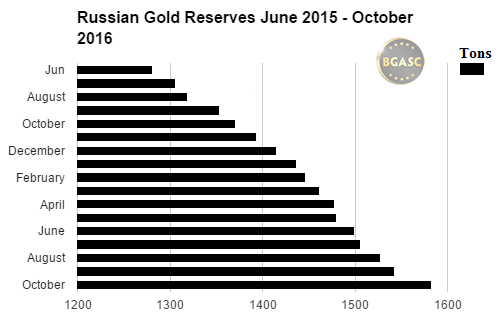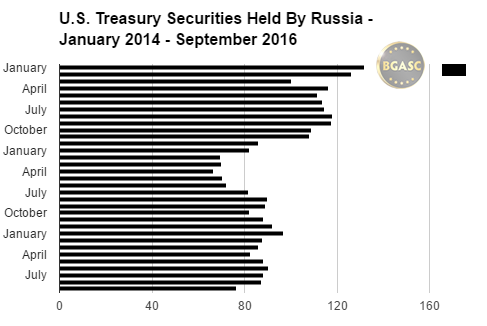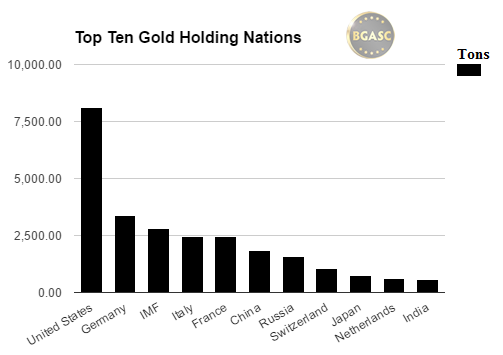
Russian Gold Reserves Swell 40 Tons in October
The Central Bank of Russia Added Over 40 Tons of Gold in October.
The Russian Central Bank announced this week that its gold reserves had reached 50.6 million troy ounces (approximately 1,583 metric tons). The total included an additional 1,300,000 ounces (approximately 40 metric tons) of gold added in October.
The 1.3 million ounces of gold added to Russia’s reserves in October were the most added in any single month by Russia since 1999.

Year to date, the Russian Central Bank has added over 165 tons of gold to reserves. Over the past two years, Russia has led the world in adding gold to her central bank reserves, ahead of the People’s Bank of China, the central bank that has added the second largest of amount of gold during the same time period.
The Central Bank of Russia added a record 208 tons of gold to reserves in 2015. Last year, Russia suffered financially as international sanctions and plummeting oil prices took their toll on the rouble and the inflation rate reached double digits. According to the World Bank, oil is by far Russia’s largest export and represents about 15-20% of Russia’s GDP and the majority of government revenues. 2016 has started off better for Russia. The price of oil and gold have increased significantly in 2016 and have helped Russia improve its financial situation and reserves.
The pace of Russia’s gold purchases had slacked slightly in 2016 compared to 2015. Through September 2016, the Russian Central Bank has added 4.1 million ounces of gold to reserves compared to 4.7 million ounces added in 2015 during the same time period. October’s addition of 1.3 million ounces of gold, however, puts Russia’s 2016 gold additions ahead of last year’s pace. Year to date through October 2016, the Russian Central Bank has added 5.4 million ounces of gold, vs 5.3 million ounces added through October 2016.

Russia Adds Gold To Reserves Despite Economic Weakness
Russian foreign reserves were at $371 billion in January and grew to $397.7 billion as at September 30, 2016. Overall Russian foreign reserves fell about $7 billion to $390.7 billion as of October 31, 2016, despite the massive addition of 40 tons of gold in October.
Despite the weakness in the Russian economy, the Russian Central Bank has bolstered its foreign reserves from about $350 billion a year ago to over $397 billion at the end of September 2016. The Russian Central Bank has a stated goal of increasing reserves to about $500 billion in the coming years. Russian sovereign wealth funds have not fared as well and have lost about $90 billion in value since 2008, falling to about $32 billion.
As of October 31, 2016, gold constituted about 13% of the Central Bank of Russia’s $390.7 billion reserves with her gold hoard valued at approximately $52 billion.
U.S. Treasuries as Part of Russia’s Foreign Reserves
In January 2014, Russia’s U.S. Treasury position was $131 billion. In reaction to U.S. inspired sanctions being placed on her, Russia sold a substantial portion of her U.S. Treasury holdings. Russian U.S. Treasury holdings reached a low of $66.5 billion in April 2015. Since then Russia has added back a portion of its U.S. Treasury holdings. As of September 2016, Russia held $76.5 billion in U.S. Treasury Securities.

The Gold Option
Russia’s pace of adding gold to reserves is the fastest in the world, surpassing China whose gold reserve additions over the past year are the second highest.From October to October 2016 China added 134 tonnes of gold to its reserves, while Russia added 230 tonnes, or 70% more!
As a result of Russia’s gold buying binge, Russia has vaulted into the top ten gold holding nations and is now the sixth largest.

Russia’s decision to add gold to reserves has paid off as the price of gold has risen nearly 30% over the past year, with most of the gain coming in 2016. Russian gold mining produces the third largest annual output in the world. Exchanging depreciating Roubles for a good portion of their gold mining output has helped increase the value of Russia’s reserves. By retaining an increasing percentage of its gold mining output the Central Bank of Russia has been in effect converting roubles into gold.
This article by BGASC is not, and should not be regarded as, investment advice or as a recommendation regarding any particular course of action.
